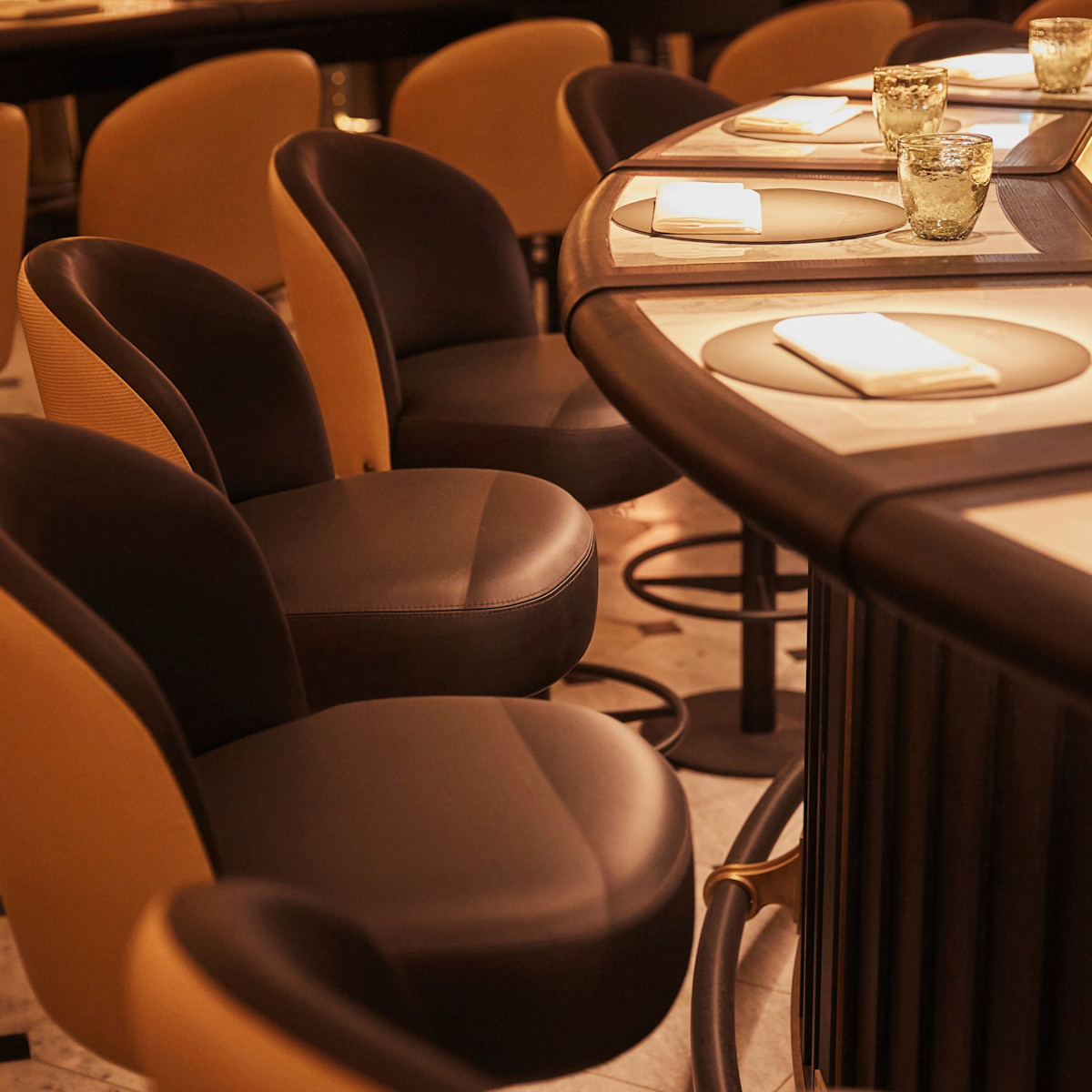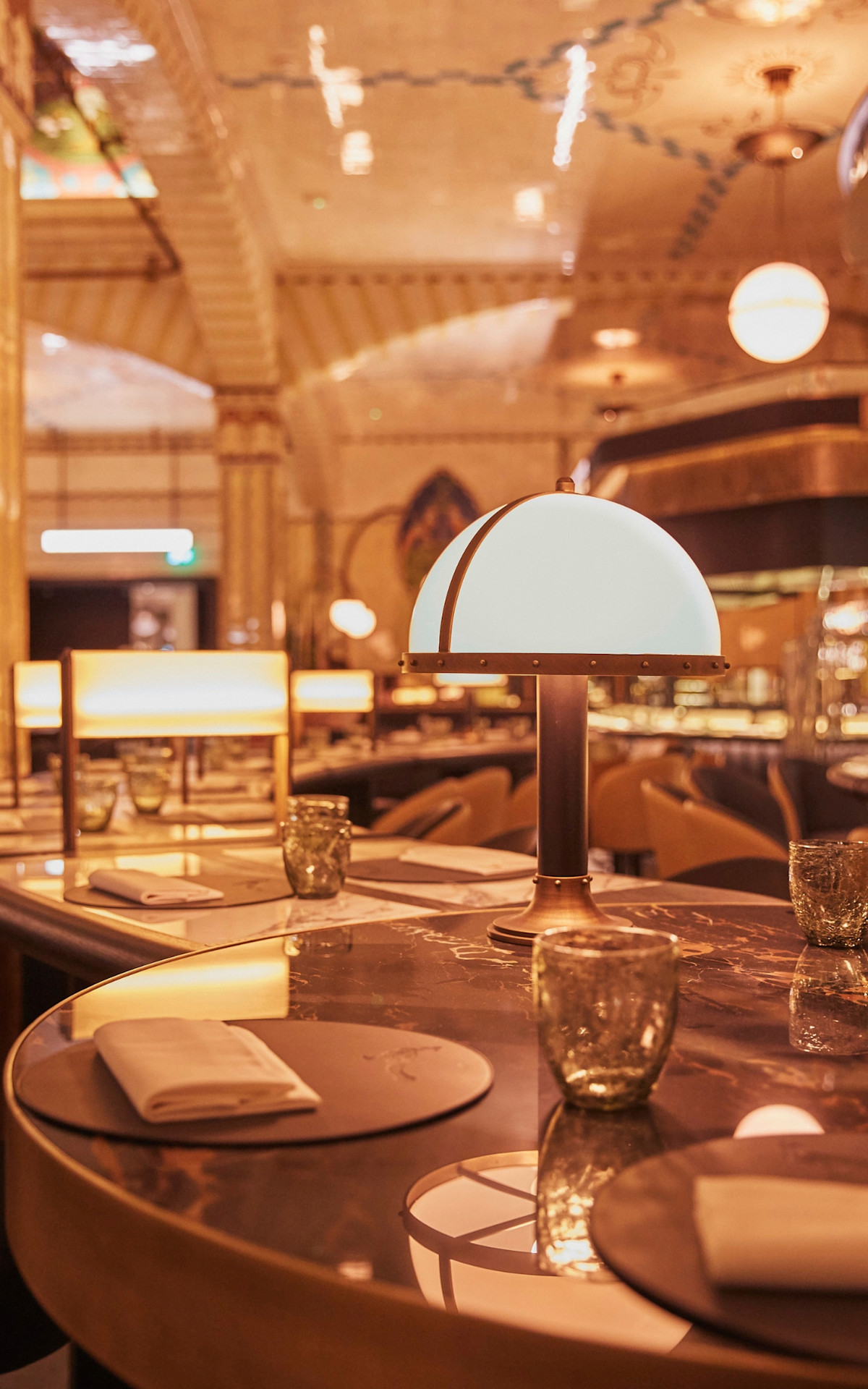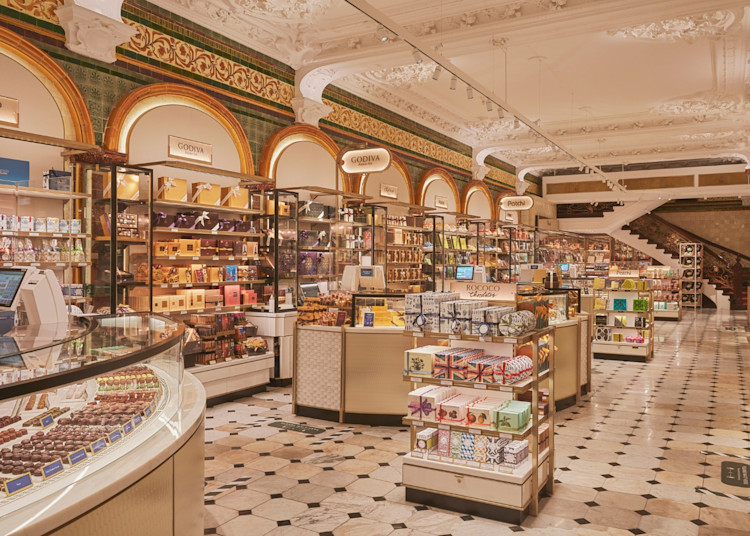London, 2018
Harrods Dining Hall
David Collins Studio has reimagined Harrods’ Dining Hall with a delicate balance of historical reverence and modern elegance. This bold transformation of the Grade II-listed Meat and Fish Hall blends the grandeur of its Edwardian origins with a contemporary dining experience, incorporating five distinct dining counters, each with its own personality, yet united by a sophisticated material palette of timber, leather, marble, and brass.
William Neatby’s unique designs for the Royal Doulton ceramic tilework form the most delightful historic and unique backdrop to The Dining Hall at Harrods. By restoring the room, we have re-awakened the colour, crafted quality, and gilded splendour of this very special Hall.
Simon Rawlings, Chief Creative Officer, David Collins Studio
The new Harrods Dining Hall is a design spectacular. A masterpiece of golden sophistication, never have the words ‘food glorious food’ been better suited to a place.
Annabel Sampson, Tatler
Guests are welcomed into the new hall by a buzzing atmosphere, beautiful stone pillars, and floor-to-ceiling art deco tiles. The redesign came at the hands of the David Collins Studio and the ceiling alone is a sight to behold: high arches and 1920s hand-painted tiles with pops of colour cast a glow across the room.
Ina Yulo, Billionaire
‘It’s not about taking Harrods back to Edwardian times,’ says Simon Rawlings, Creative Director of David Collins Studio at the unveiling of the new Dining Hall. ‘It is about using what we’ve got in an imaginative way. When we study a building’s archives we take inspiration from it as a whole, rather than just a series of rooms. It’s very important that it‘s not a themed pastiche, but sensitively done and thought through with nods to the past.’
Rawlings should know. He’s spent over two decades at David Collins Studio, mastering the art of creating timeless interiors that authentically celebrate the past, while also becoming modern classics. Still, the transformation of the Meat and Fish Hall – a decoratively tiled, Grade II-listed retail space – into a modern Dining Hall for 200 diners was a major undertaking for the studio. This is the third phase of Harrods’ two-year overhaul of the store’s four historic Food Halls and without doubt the jewel in the crown of the whole enterprise.
To ensure their vision would meet the approval of Historic England, David Collins Studio called upon the insider knowledge of Harrods resident archivist Sebastian Wormell and, later, the artisanal expertise of Victorian tile specialists Craven Dunhill Jackfield. ‘Harrods always give us a detailed brief, and with heritage teams involved, the whole process often becomes a collaborative effort to some extent,’ says Rawlings. ‘Most importantly we had to respect the fact that they are a hall, so in each one we have retained views – you can still experience the beauty of the hall.’
This grand, tiled space with its beautiful columns, arches and extraordinary central coffer, lined with an elaborate frieze of hunting scenes and livestock, such as wild boar, geese and sheep, made waves when first unveiled in 1903. Glowing press reviews appeared as far afield as an art journal in Vienna, although less sophisticated critics scorned such a high level of artistry and craft being applied to a transitory retail space.
The art-nouveau-meets-arts-and-crafts interior was conceived by Barnsley-born architect William Neatby, a disciple of William Morris who, like him, diversified into decorative arts, metalwork, design, furniture and illustration. His forte though was ceramics, and for a period he ran the architecture department of Lambeth-based Doulton & Co’s tilemakers, precursors to Royal Doulton, who supplied the tiles for Harrods. ‘Neatby had only nine weeks to complete the design,’ says Wormell, ‘it meant probably adapting some designs he’d already done elsewhere in the UK, but it shows just how inventive he was.’
The team at David Collins Studio had to be equally resourceful, both conceptually and practically. ‘A space that is so dominant in detail and design can be overwhelming,’ says Rawlings, who has worked on similarly impressive dining rooms in the capital such as The Wolsesley and Kerridge‘s Bar & Grill. ‘Diners always need to feel welcome and comfortable, so we have created these intimate pockets that enable people to settle in, enjoy the company and the food, while still taking in the whole interior.’
Their solution is five restaurants in one big, buzzing brasserie. Designed as individual dining counters with their own dedicated kitchens, they line the two longest walls of the hall around the centrepiece; an oval, scallop-edged Wine Bar, where guests can sit and gaze up at the ornate pastoral scenes above their heads. The Fish Bar, The Pasta Bar, The Grill, The Sushi Bar and Kama by Vineet Bhatia – all share a cohesive unifying palette of materials: rich dark timber, mahogany-hued leather, marble and brass. But there are subtle differences defining them, most noticeably in the decorative finishes above diners’ heads, pasta is signified by glass Murano discs, the grill has rodded glass akin to a brasserie detail and the fish counter a finish like fish scales. There are various seating options throughout, from high, long, snaking counters for individuals and couples, to stools at the counters overlooking the chef action, and tables for four or more in a conventional restaurant setting.
As with every David Collins Studio project, clever lighting injects glamour and here creates intimacy for diners, while bringing to life the rich interior decoration. Once the hall was filled with natural light, filtered down through a glass roof thus illuminating the central coffer, but now this is closed off with womenswear sitting on the floor above. David Collins Studio created a warm, inviting glow with recessed lighting that washes over the iridescent glazed tiles, table lamps on every countertop, globe pendants and concealed dome uplighters that catch the gilded ceiling cartouches so they glint and sparkle.
‘We worked hard to get the colour balance in the right places,’ says Rawlings. ‘We’ve taken our experience and understanding of how people like to eat and I always like to present food on a light surface, so we created these stone surfaces inlaid into the darker countertop. The table lights really highlight the food. There are layers of light, so not one thing feels dominant.’
The tiles are undoubtedly the star of the show and although it appears that the originals remain intact, much restoration and replacement work was undertaken by Craven Dunhill Jackfield, who also worked with the Studio on the Roastery & Bake Hall and Fresh Market Hall. Matching pigments was one of their toughest challenges, with some colours proving particularly tricky. Each tile is hand-dipped in metal oxides to give them that distinctive shine. ‘It’s like stained glass on a piece of clay’, says Production Director Adrian Blundell, ‘so you get this rich, warm, iridescent colour.’ Cartouches too, initially gilded, had dulled over the years by over-zealous cleaning, so some were reproduced and re-gilded.
William Neatby would no doubt be pirouetting for joy in his grave if he knew that today his ceramic masterpiece has not only survived, but been reinvented anew. Today people can truly pause and admire his artistry, and possibly for another 100 years.
Written by Bethan Ryder
Photography by Kensington Leverne
Awards
Casambi Awards 2021
Casambi Technologies
Commercial and Hospitality category, Créateurs Selects
Créateurs Design Awards
Press
Hot Dinners
Harrods' big food hall revamp continues as The Dining Hall is unveiled
Eater London
Michelin Starred Indian Restaurant Pioneer Has Opened a 26-Seater in Harrods
The Standard
Harrods unveils new Dining Hall, complete with Indian restaurant and a sushi bar
Tatler
The new Harrods Dining Hall is a design spectacular
Billionaire
Inside Harrods' Newly Renovated Dining Hall
Related projects
Harrods Fresh Market Hall, London
Retail
The Wolseley, London
Hospitality
Harrods Chocolate Hall, London
Retail
Harrods Womenswear, London
Retail












